Intel NUC Hades Canyon with AMD Vega graphics - VR or not VR?
When the first Intel NUC mini-PC with Intel HD / AMD Vega hybrid graphics was announced at the beginning of this year, many good words were said about it - the most interesting of them were quoted on the blog . Indeed, the device turned out to be remarkable, never before had Intel (and perhaps no one at all) concentrated so much computing power in such a small amount. Among other advances, the two devices met two that we wanted to test: "The new NUC can compete on equal terms with systems based on NVIDIA GTX 1060 " and " Intel NUC Hades Canyon is the smallest VR-compatible platform ." And checked.
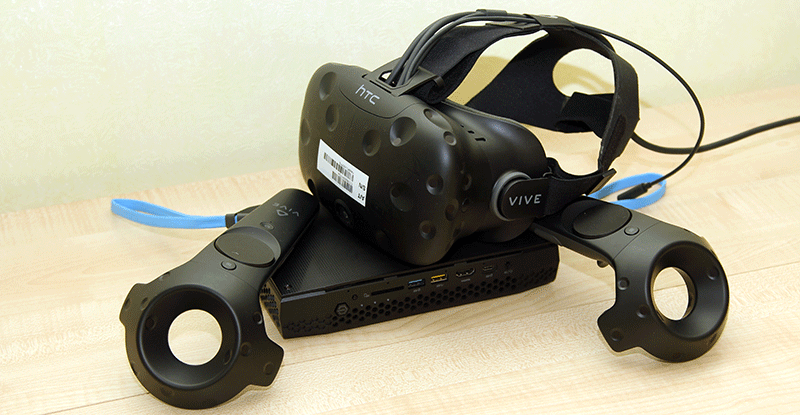
I would like to start my post with a section in the rare unpacking genre for an Intel blog. Here in such a huge chest with a luminous lid came to the office of Intel NUC Hades Canyon.
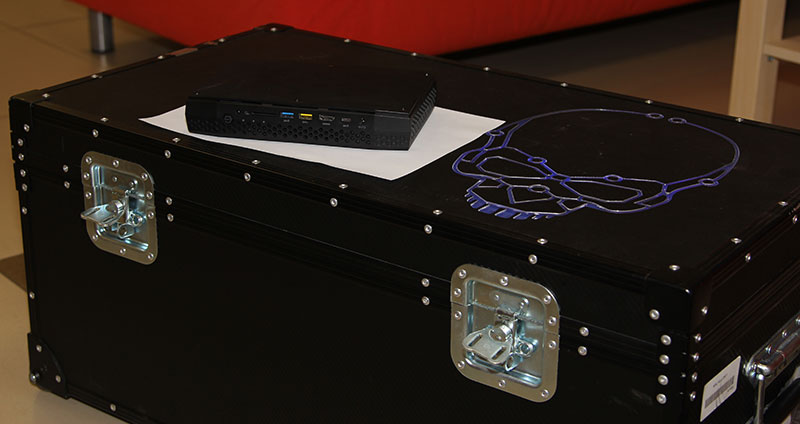
Under the lid in a multi-layered piece of foam rubber are the constituent parts of Intel NUC and the VR kit Oculus Rift.
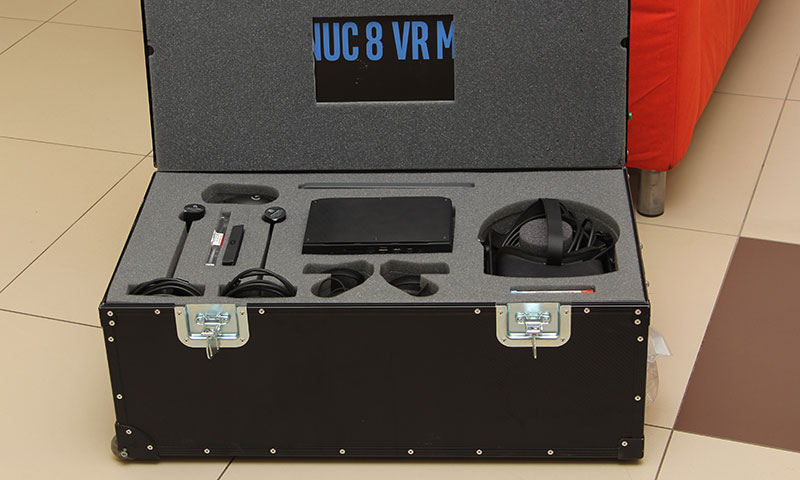
True, we had technical problems with Oculus, so most of the experiments were carried out with the VR HTC Vive - it is on the KDPV.
Compared with its predecessor, Intel NUC Skull Canyon (thus, called the “first game NUC” - we will come back to this), Hades Canyon is bigger and heavier, which is not surprising given the number of ports and the new cooling system, and it is really good. As for the configuration, then we had it next.
A variety of ports you can appreciate by the photo. Front: card reader, three USB 3.0 / 3.1 Type-A ports, one USB 3.1 Type-C, HDMI output and a 3.5mm audio jack.
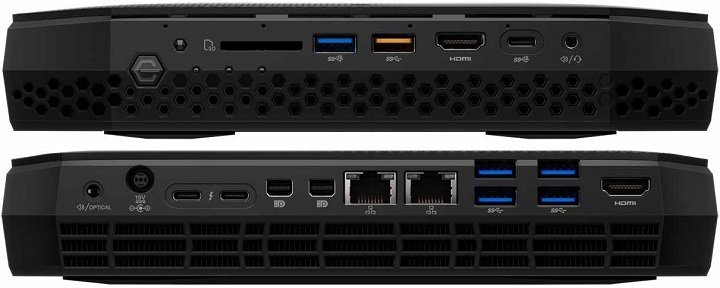
Back: as many as four USB 3.0 Type-A ports, HDMI, two mini-DisplayPort, two RJ-45, two Thunderbolt 3 connectors compatible with USB 3.1 Type-C, and optical S / PDIF. Why does the NUC have so many USB ports? Do not forget about VR.
The appearance of the NUC is definitely attractive, it is very decoration in the form of a glowing skull. You can complain about the size of the power supply, which this time is just a little less than the computer itself, but this is a necessary measure, because at peak load the kid consumes up to 120 watts of electricity.
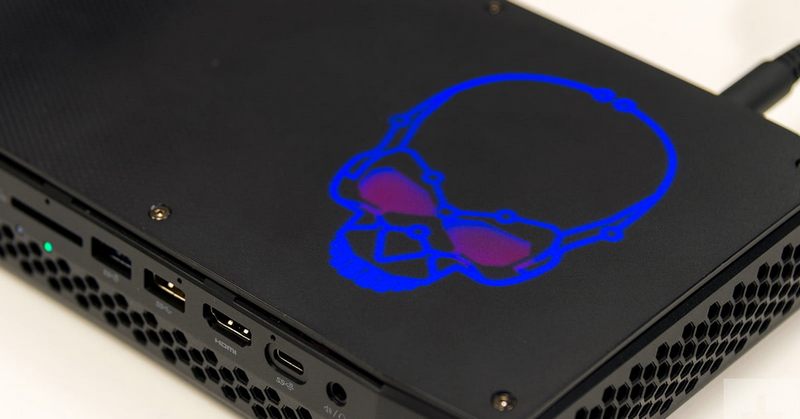
We turn to the first question of interest to us: the performance of the graphics subsystem Intel NUC Hades Canyon. I will give advice to its future owners: in order to avoid unpleasant surprises that happened to me at first, be sure to completely update all drivers before use. Moreover, a special program Intel Driver & Support Assistant has been created for these purposes that will do everything for you.
To test the performance, we applied our standard benchmark set - this allowed us to compare the results for key positions with those of the previous Intel NUC Skull Canyon model. As a reference, it was logical to use a PC with an Nvidia GeForce GTX 1060 6 GB video card and an Intel Core i7-6700 processor. The picture turned out next.
So, on the one hand, AMD Vega graphics demonstrates a significant performance increase compared to Intel Iris Pro and the new NUC, unlike the previous one, without a stretch can be called gaming. This is confirmed by our colleagues from 3DNews, who tested the Intel NUC Hades Canyon on real games. Their conclusion: "This NUC is really suitable for modern games at high graphics quality settings in Full HD resolution."
On the other hand, it is obvious that parity with powerful discrete graphics has not yet been achieved. In synthetic tests, it can be seen especially clearly, however, and in real games, as shown in the same 3DNews test, the GeForce GTX 1060 has a 20% advantage. Translated into custom, this means that where the 1060 pulls its settings quietly, the NUC works with voltage. But it works! There is a reason to praise again the cooling of Hades Canyon: it is really efficient and quiet, no wonder engineers were proud of it.
First, a small digression. Before that, I had almost nothing to do with virtual reality and did not try any helmets. Therefore, I also wanted to understand how “advanced” the VR technologies were in their development, and do it according to the following criteria:
In order. Installing HTC Vive took me 2 hours - this, along with downloading multi-gigabyte software. Step-by-step instructions guide you through the whole process, telling you where to put and what to grab. Configuring the scene from the side probably looks funny, although playing in a helmet is no less. After the system is ready, your room is wired and this, of course, is a minus. The wires on the helmet especially hinder, and just move around the room and feel the virtual reality. I really want a wireless connection - and Intel and HTC have some joint developments in this area. As for the sensations, then for me the picture in the helmet is a bit rough, which makes it difficult to perceive it as a reality.

As you can see, 3DMark set the NUC quite a high rating, however, it warned that its performance is slightly below the minimum of VR. As for the VRMark specialized benchmark, before its response was more developed: the total amount of parrots is sufficient, but the target frame rate is almost not reached.

In addition, the program complained about an unfamiliar graphics card. The cautious optimism of the benchmarks is true: even on heavy demo brakes were not observed, although VR was hard on a computer. In general, what you see allows you to confidently rank Intel NUC Hades Canyon as a category of VR platforms, and perhaps, indeed, the smallest among them.
Thus, the answer to the question in the title of the article is positive.
We thank Maria Kibkalo and Vika vikky13 Zhislin for the equipment provided and assistance in testing.

Preface. Unpacking
I would like to start my post with a section in the rare unpacking genre for an Intel blog. Here in such a huge chest with a luminous lid came to the office of Intel NUC Hades Canyon.

Under the lid in a multi-layered piece of foam rubber are the constituent parts of Intel NUC and the VR kit Oculus Rift.

True, we had technical problems with Oculus, so most of the experiments were carried out with the VR HTC Vive - it is on the KDPV.
Characteristics and appearance
Compared with its predecessor, Intel NUC Skull Canyon (thus, called the “first game NUC” - we will come back to this), Hades Canyon is bigger and heavier, which is not surprising given the number of ports and the new cooling system, and it is really good. As for the configuration, then we had it next.
| CPU | Intel Core i7-8809G (Kaby Lake G, 4 cores, 8 threads, 3.1 GHz) |
| Motherboard | Intel Hades Canyon NUC8i7HVB (2 M.2, 2 DDR4 SO-DIMM, Audio, Video, Dual Gigabit LAN, CPU, Thunderbolt 3, WiFi) |
| Memory | 16 GB (DDR4 SDRAM) |
| Video 1 | Intel HD Graphics 630 |
| Video 2 | Radeon RX Vega M GH |
| Disk | INTEL SSDPEKKW512G8 (512 GB, PCI-E 3.0 x4) |

Back: as many as four USB 3.0 Type-A ports, HDMI, two mini-DisplayPort, two RJ-45, two Thunderbolt 3 connectors compatible with USB 3.1 Type-C, and optical S / PDIF. Why does the NUC have so many USB ports? Do not forget about VR.
The appearance of the NUC is definitely attractive, it is very decoration in the form of a glowing skull. You can complain about the size of the power supply, which this time is just a little less than the computer itself, but this is a necessary measure, because at peak load the kid consumes up to 120 watts of electricity.

Graphics testing
We turn to the first question of interest to us: the performance of the graphics subsystem Intel NUC Hades Canyon. I will give advice to its future owners: in order to avoid unpleasant surprises that happened to me at first, be sure to completely update all drivers before use. Moreover, a special program Intel Driver & Support Assistant has been created for these purposes that will do everything for you.
To test the performance, we applied our standard benchmark set - this allowed us to compare the results for key positions with those of the previous Intel NUC Skull Canyon model. As a reference, it was logical to use a PC with an Nvidia GeForce GTX 1060 6 GB video card and an Intel Core i7-6700 processor. The picture turned out next.
| Benchmark | Intel NUC Skull Canyon | Intel NUC Hades Canyon | GTX 1060 & Core i7-6700 |
|---|---|---|---|
| Geekbench (CPU test) | 14208 | 16971 | - |
| Geekbench (GPU test) | 37616 | 85576 | 130797 |
| Unigine Heaven | 396 | 1718 | 2970 |
| 3dmark | 1975 | 3079 | 4143 |
| VRMark | - | 4925 | 7179 |
On the other hand, it is obvious that parity with powerful discrete graphics has not yet been achieved. In synthetic tests, it can be seen especially clearly, however, and in real games, as shown in the same 3DNews test, the GeForce GTX 1060 has a 20% advantage. Translated into custom, this means that where the 1060 pulls its settings quietly, the NUC works with voltage. But it works! There is a reason to praise again the cooling of Hades Canyon: it is really efficient and quiet, no wonder engineers were proud of it.
VR Testing
First, a small digression. Before that, I had almost nothing to do with virtual reality and did not try any helmets. Therefore, I also wanted to understand how “advanced” the VR technologies were in their development, and do it according to the following criteria:
- easy installation and configuration
- the convenience of use,
- vitality of sensations.
In order. Installing HTC Vive took me 2 hours - this, along with downloading multi-gigabyte software. Step-by-step instructions guide you through the whole process, telling you where to put and what to grab. Configuring the scene from the side probably looks funny, although playing in a helmet is no less. After the system is ready, your room is wired and this, of course, is a minus. The wires on the helmet especially hinder, and just move around the room and feel the virtual reality. I really want a wireless connection - and Intel and HTC have some joint developments in this area. As for the sensations, then for me the picture in the helmet is a bit rough, which makes it difficult to perceive it as a reality.

As you can see, 3DMark set the NUC quite a high rating, however, it warned that its performance is slightly below the minimum of VR. As for the VRMark specialized benchmark, before its response was more developed: the total amount of parrots is sufficient, but the target frame rate is almost not reached.

In addition, the program complained about an unfamiliar graphics card. The cautious optimism of the benchmarks is true: even on heavy demo brakes were not observed, although VR was hard on a computer. In general, what you see allows you to confidently rank Intel NUC Hades Canyon as a category of VR platforms, and perhaps, indeed, the smallest among them.
Thus, the answer to the question in the title of the article is positive.
We thank Maria Kibkalo and Vika vikky13 Zhislin for the equipment provided and assistance in testing.
